
SMU price ranges: Sheet indices mixed, plate stable
SMU’s steel price indices were mixed this week as the market seeks direction. All of our indices have fluctuated within relatively narrow ranges across September.

SMU’s steel price indices were mixed this week as the market seeks direction. All of our indices have fluctuated within relatively narrow ranges across September.
Nucor’s weekly consumer spot price (CSP) for hot-rolled (HR) coil increased $10 per short ton (st) from last week to $730/st as of Monday, Sept. 23.
The premium galvanized coil prices carry over hot-rolled (HR) coil continues to shrink, according to SMU price indices.
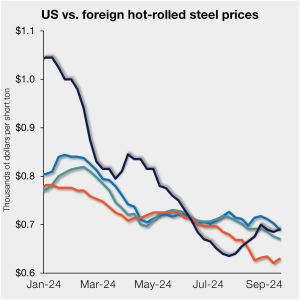
US hot-rolled (HR) coil prices edged up this past week and remain modestly more expensive than offshore material on a landed basis. Since reaching parity with import prices in late August, domestic prices have been slowly pulling ahead of imports. The move has been driven largely by declines overseas.
Cleveland-Cliffs is seeking $750 per short ton (st) for hot-rolled coil. That’s $20/st above where the steelmaker had been. It’s also $30/st above Nucor, which is at $720/st this week. We've seen prices increase incrementally this week. SMU's HR price, for example, stands at $690/st on average, up $5/st from last week. The questions now are whether a number well above $700/st will stick, whether other mills will follow Cliffs, and whether there is enough demand to support higher prices.
Cleveland-Cliffs aims to increase prices for hot-rolled (HR) coil to $750 per short ton (st) effective immediately. The move represents a price hike of $20/st from the Cleveland-based steelmaker's previously published price of $730/st.
Steel Dynamics Inc. (SDI) expects lower third-quarter earnings on the heels of “meaningfully lower” prices at its flat-rolled steel operations. The Fort Wayne, Ind.-based steelmaker expects Q3’24 earnings of $1.94 to $1.98 per diluted share, according to figures released on Monday. That’s down from $2.72 per share in Q2’24 and down from $3.47 per share in Q3’23.
Nucor’s weekly consumer spot price (CSP) for hot-rolled (HR) coil is unchanged from last week.

The price spread between hot-rolled coil (HRC) and prime scrap widened again in September, according to SMU’s most recent pricing data.
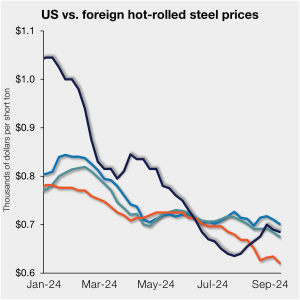
US hot-rolled (HR) coil prices edged down slightly this past week but remain at a slight premium to offshore material on a landed basis.

SMU’s steel price indices showed mixed signals for a second consecutive week. Our hot rolled, cold rolled, and plate price indices inched lower from last week, as the galvanized index held steady and Galvalume's ticked higher.
Nucor has raised its weekly consumer spot price (CSP) by $10 per short for hot-rolled (HR) coil to $720/st.
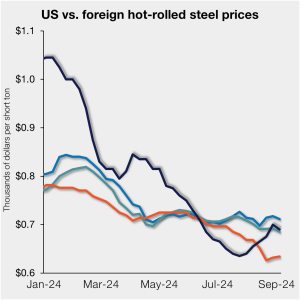
US hot-rolled (HR) coil prices were largely flat over the past week, remaining higher than tags for offshore material on a landed basis for a second consecutive week.

SMU indices moved higher on cold rolled products this week, while galvanized prices were flat. Our indices for plate, hot rolled, and Galvalume all edged lower.
Dan Needham has been with Nucor for 24 years, and he said the key to that longevity has been the company’s culture.

The price spread between hot-rolled (HR) coil and prime scrap widened slightly in August but remains in territory not seen since late 2022, according to SMU’s most recent pricing data.

Sheet prices trended sideways to modestly up this week in a market that appears to be in “wait-and-see” mode.

Fall is coming in North America, and with it, steel mills' regularly scheduled fall maintenance outages.

Steel buyers continue to report short mill lead times for both sheet and plate products, according to SMU's latest canvass of the market. Lead times for hot-rolled and plate products marginally increased from our late July survey, likely due to limited restocking in anticipation of upcoming mill outages for scheduled maintenance.
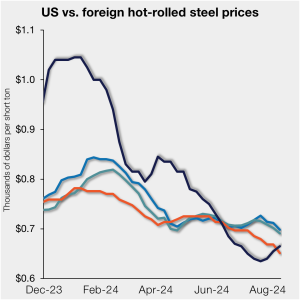
US hot-rolled (HR) coil prices are nearly even with prices for offshore material on a landed basis as domestic tags continue to inch up.

The European Commission has initiated a trade case investigating allegedly dumped hot-rolled coil imports from Egypt, India, Japan, and Vietnam. The European Steel Association (EUROFER) filed the complaint in June, according to an Aug. 8 notice in the Official Journal of the European Union.
I asked in a prior Final Thoughts where some of you thought Nucor’s weekly spot HR price would land. One opinion: $720 per short ton (st). That would allow the Charlotte, N.C.-based steelmaker to one up competitor Cleveland-Cliffs and to re-establish its position as a market leader.

The Court of International Trade (CIT) has ruled against BlueScope Steel and its affiliates' challenge of a sunset review of the antidumping duties on hot-rolled (HR) steel flat imports.
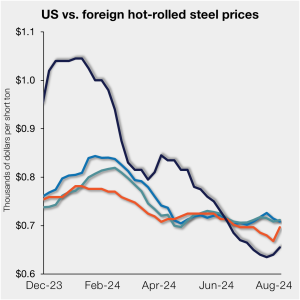
US hot-rolled (HR) coil remains cheaper than offshore material on a landed basis despite domestic tags inflecting upward lately. But the spread between domestic and foreign HR has tightened on the heels of price hikes by US mill over the past two weeks. (Visit SMU’s price increase calendar to keep track of the latest mill price announcements).

SMU’s sheet price was largely flat this week, an unusual sight for the better part of the past four months. The same trend was seen for tandem products and plate as well.
Nucor has raised its consumer spot price (CSP) for hot-rolled (HR) coil to $675 per short ton (st), up $25/st from last week.
Both iron ore and coking coal prices fell this week because of resistance from buyers. Iron ore prices have continued to fall throughout the past week, following sharp declines in steel prices in China, given no new policy announcement from the ‘Third Plenum’ meeting.

Summer is here, and a familiar sentiment has hit the hot-rolled coil (HRC) futures market. Prices continue to decline in both the spot market and the futures market, with expectations of sub-$800 prices for the remainder of the year.
High levels of steel imports, especially from China, in recent months are worrying steel makers in India and Vietnam.

SMU’s sheet price ranges slid again this week. But the declines were more pronounced on tandem products whereas prices for hot-rolled coil held roughly steady.